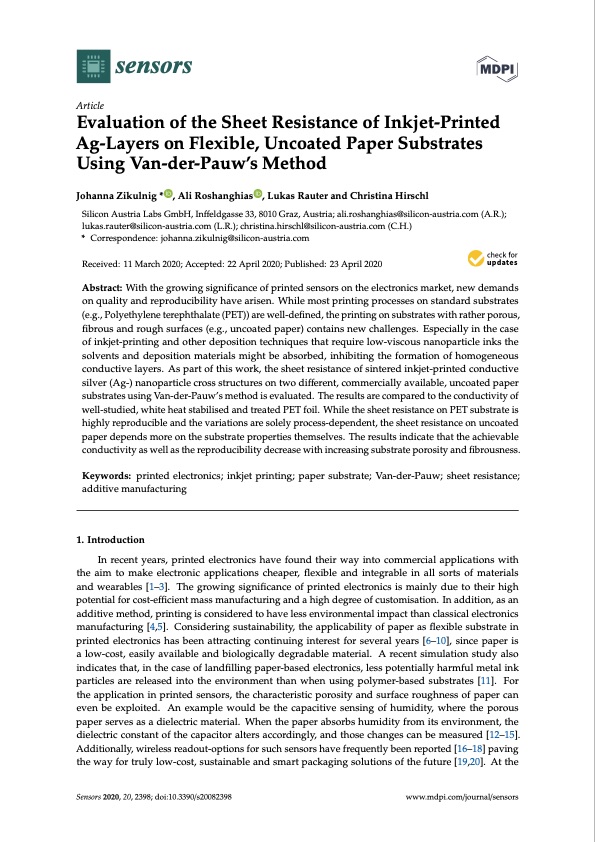
PDF Publication Title:
Text from PDF Page: 001
sensors Article Evaluation of the Sheet Resistance of Inkjet-Printed Ag-Layers on Flexible, Uncoated Paper Substrates Using Van-der-Pauw’s Method Johanna Zikulnig * , Ali Roshanghias , Lukas Rauter and Christina Hirschl Silicon Austria Labs GmbH, Inffeldgasse 33, 8010 Graz, Austria; ali.roshanghias@silicon-austria.com (A.R.); lukas.rauter@silicon-austria.com (L.R.); christina.hirschl@silicon-austria.com (C.H.) * Correspondence: johanna.zikulnig@silicon-austria.com Received: 11 March 2020; Accepted: 22 April 2020; Published: 23 April 2020 Abstract: With the growing significance of printed sensors on the electronics market, new demands on quality and reproducibility have arisen. While most printing processes on standard substrates (e.g., Polyethylene terephthalate (PET)) are well-defined, the printing on substrates with rather porous, fibrous and rough surfaces (e.g., uncoated paper) contains new challenges. Especially in the case of inkjet-printing and other deposition techniques that require low-viscous nanoparticle inks the solvents and deposition materials might be absorbed, inhibiting the formation of homogeneous conductive layers. As part of this work, the sheet resistance of sintered inkjet-printed conductive silver (Ag-) nanoparticle cross structures on two different, commercially available, uncoated paper substrates using Van-der-Pauw’s method is evaluated. The results are compared to the conductivity of well-studied, white heat stabilised and treated PET foil. While the sheet resistance on PET substrate is highly reproducible and the variations are solely process-dependent, the sheet resistance on uncoated paper depends more on the substrate properties themselves. The results indicate that the achievable conductivity as well as the reproducibility decrease with increasing substrate porosity and fibrousness. Keywords: printed electronics; inkjet printing; paper substrate; Van-der-Pauw; sheet resistance; additive manufacturing 1. Introduction In recent years, printed electronics have found their way into commercial applications with the aim to make electronic applications cheaper, flexible and integrable in all sorts of materials and wearables [1–3]. The growing significance of printed electronics is mainly due to their high potential for cost-efficient mass manufacturing and a high degree of customisation. In addition, as an additive method, printing is considered to have less environmental impact than classical electronics manufacturing [4,5]. Considering sustainability, the applicability of paper as flexible substrate in printed electronics has been attracting continuing interest for several years [6–10], since paper is a low-cost, easily available and biologically degradable material. A recent simulation study also indicates that, in the case of landfilling paper-based electronics, less potentially harmful metal ink particles are released into the environment than when using polymer-based substrates [11]. For the application in printed sensors, the characteristic porosity and surface roughness of paper can even be exploited. An example would be the capacitive sensing of humidity, where the porous paper serves as a dielectric material. When the paper absorbs humidity from its environment, the dielectric constant of the capacitor alters accordingly, and those changes can be measured [12–15]. Additionally, wireless readout-options for such sensors have frequently been reported [16–18] paving the way for truly low-cost, sustainable and smart packaging solutions of the future [19,20]. At the Sensors 2020, 20, 2398; doi:10.3390/s20082398 www.mdpi.com/journal/sensorsPDF Image | Inkjet-Printed Ag-Layers on Flexible, Uncoated Paper Substrates

PDF Search Title:
Inkjet-Printed Ag-Layers on Flexible, Uncoated Paper SubstratesOriginal File Name Searched:
sensors-20-02398-v2.pdfDIY PDF Search: Google It | Yahoo | Bing
Turbine and System Plans CAD CAM: Special for this month, any plans are $10,000 for complete Cad/Cam blueprints. License is for one build. Try before you buy a production license. More Info
Waste Heat Power Technology: Organic Rankine Cycle uses waste heat to make electricity, shaft horsepower and cooling. More Info
All Turbine and System Products: Infinity Turbine ORD systems, turbine generator sets, build plans and more to use your waste heat from 30C to 100C. More Info
CO2 Phase Change Demonstrator: CO2 goes supercritical at 30 C. This is a experimental platform which you can use to demonstrate phase change with low heat. Includes integration area for small CO2 turbine, static generator, and more. This can also be used for a GTL Gas to Liquids experimental platform. More Info
Introducing the Infinity Turbine Products Infinity Turbine develops and builds systems for making power from waste heat. It also is working on innovative strategies for storing, making, and deploying energy. More Info
Need Strategy? Use our Consulting and analyst services Infinity Turbine LLC is pleased to announce its consulting and analyst services. We have worked in the renewable energy industry as a researcher, developing sales and markets, along with may inventions and innovations. More Info
Made in USA with Global Energy Millennial Web Engine These pages were made with the Global Energy Web PDF Engine using Filemaker (Claris) software.
Infinity Turbine Developing Spinning Disc Reactor SDR or Spinning Disc Reactors reduce processing time for liquid production of Silver Nanoparticles.
| CONTACT TEL: 608-238-6001 Email: greg@infinityturbine.com | RSS | AMP |